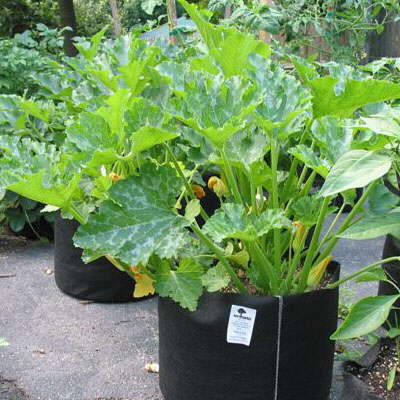There are a lot of reasons why someone would want to grow herbs and veggies in containers rather than in the ground. Whatever the reason you’ve gotten into it, or have decided to research how to go about it successfully, there’s a few things you should know.
1) Forget about it being pretty. Pretty pots are for looks, not eating.
2) Soilless potting mix won’t produce the flavor or abundance that real soil growing will.
The problem with soilless mix is it is hard to deliver good moisture consistency for a number of reasons. For starters, it’s designed to drain sharply – kind of like growing in sand inside a fish bowl. Next, the heat inside the resin or plastic pot you’re using on a summer afternoon soars to ungodly levels.
Secondly, acid-loving plants like rhododendrons do better in soilless mix pH levels than your sweeter soil loving peppers, tomatoes and what not prefer. This affects their nutrient uptake and ultimately, your harvest. There is a profound difference in the flavor of produce grown in soils that camellias love and make hydrangeas turn blue. Being from the north where most soil is naturally in that happiness zone for fruits and vegetables, I never realized such a thing was possible until spending a couple of years in the Piedmont. That red southern soil is hard to grow things in without amending it, and trying to find homegrown flavor I’m accustomed to in Carolinas farm stand always left me wanting. I thought it was my taste buds. It wasn’t. They returned to working order as soon as I returned to the Great Lakes region.
Even if you have great backyard garden and have tossed that stray cherry tomato into a pot instead, you will notice a definite difference in how they taste. The soil-grown version will be sweeter. But you can’t grow in real soil when you’re potting in normal pots – be they clay, plastic, resin,or ceramic. If you do, the plants will die from lack of drainage.
But Smart Pots Change Everything
 You may have seen fabric pots for sale at any seed house, and maybe even your local garden center. Some brands come in snazzy decorator colors too, though your peppers, eggplant, potatoes and tomatoes could care less what color their roots are wrapped in. What they do care about is air flow, moisture availability, nutrient uptake, and lots of sunshine. They also don’t care for having to grow miles of roots in a circle along the hard sides of your pretty container looking for air, and when they have to deal with that situation they’ll not be as productive as they should. Fabric pots give them all of this and more.
You may have seen fabric pots for sale at any seed house, and maybe even your local garden center. Some brands come in snazzy decorator colors too, though your peppers, eggplant, potatoes and tomatoes could care less what color their roots are wrapped in. What they do care about is air flow, moisture availability, nutrient uptake, and lots of sunshine. They also don’t care for having to grow miles of roots in a circle along the hard sides of your pretty container looking for air, and when they have to deal with that situation they’ll not be as productive as they should. Fabric pots give them all of this and more.
Not only do your food-bearing and herb plants get air to the roots that they need to develop a full, healthy, and well-developed root system, but you can grow in real soil in them. Now, not all fabric pots are as well made as others. There are various weights in the fabric they are made from – just as there are a variety of thicknesses in weed control cloth. Smart Pot is a brand that grew out of the commercial nursery business supplying the needs of landscape shrub and tree growers. Their pots are built to last. You can use them over and over, and the prices are much better than ornamental pots and planter boxes too.
Smart Pots come in any color you want, as long as it is black or heat-reflecting tan. They’re available in sizes from 1 gallon (like the average garden center perennial pot) to 400 gallons that’s big enough for a small garden. They are reusable, washable, and you can fold them up flat for winter storage. They keep your garden’s roots cooler than any other type of growing container available, which means the plants will actually continue to grow and not stagnate like they well might do in a plastic pot where internal temps could be as high as 120 degrees!
So there you have it. The best container garden for fruits, veggies, and herbs will be grown in real soil, or a soil/compost blend in a fabric pot that is ample enough to let your plants put their best foot forward.
Learn more about Smart Pots and the magic of air pruned roots HERE.
Inline images courtesy of SmartPot.com